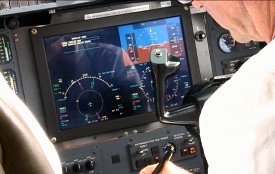
Flight testing the DERPHOSA avionics display
The DERPHOSA project saw NLR joining forces with several partners to work on new technology for cockpit displays. The new technology sailed through validation testing in 2014, at a 10-km altitude in extremely bright sunlight.
The backlights in today’s cockpit displays are based on light-emitting diode (LED) technology, using white LEDs or triple-colour LEDs. This technology is characterised by a rapidly aging and complex control system. The DERPHOSA consortium therefore set out to develop a new backlight concept, offering a simpler solution with a more stable colour yield. The new backlight system is based on colour conversion by remote phosphor. In addition to LED lighting as a light source, the new type of display makes use of a phosphor plate, which converts blue LED light into white light.
The DERPHOSA consortium consists of NDF Special Light Products (Netherlands), BARCO (Belgium), PHLOX (France) and NLR, which coordinated activities and took care of integrating the LEDs and the control system. NLR also provided support in electrical and mechanical design and conducted environmental testing for practical use. The DERPHOSA Display Unit was presented at the Farnborough Airshow in summer 2014.
NLR subsequently tested the optical properties of the new display at a 10-km altitude, using its Cessna Citation laboratory aircraft. The test flights took place over the North Sea at the end of 2014. The aircraft flew in wide arcs so that the quality of the display could be assessed with sunlight hitting the screen at various different angles.
The new display scored well during validation testing, offering better contrast and greater clarity than the current displays.
Watch the DERPHOSA video clip. Also available as extended version.


